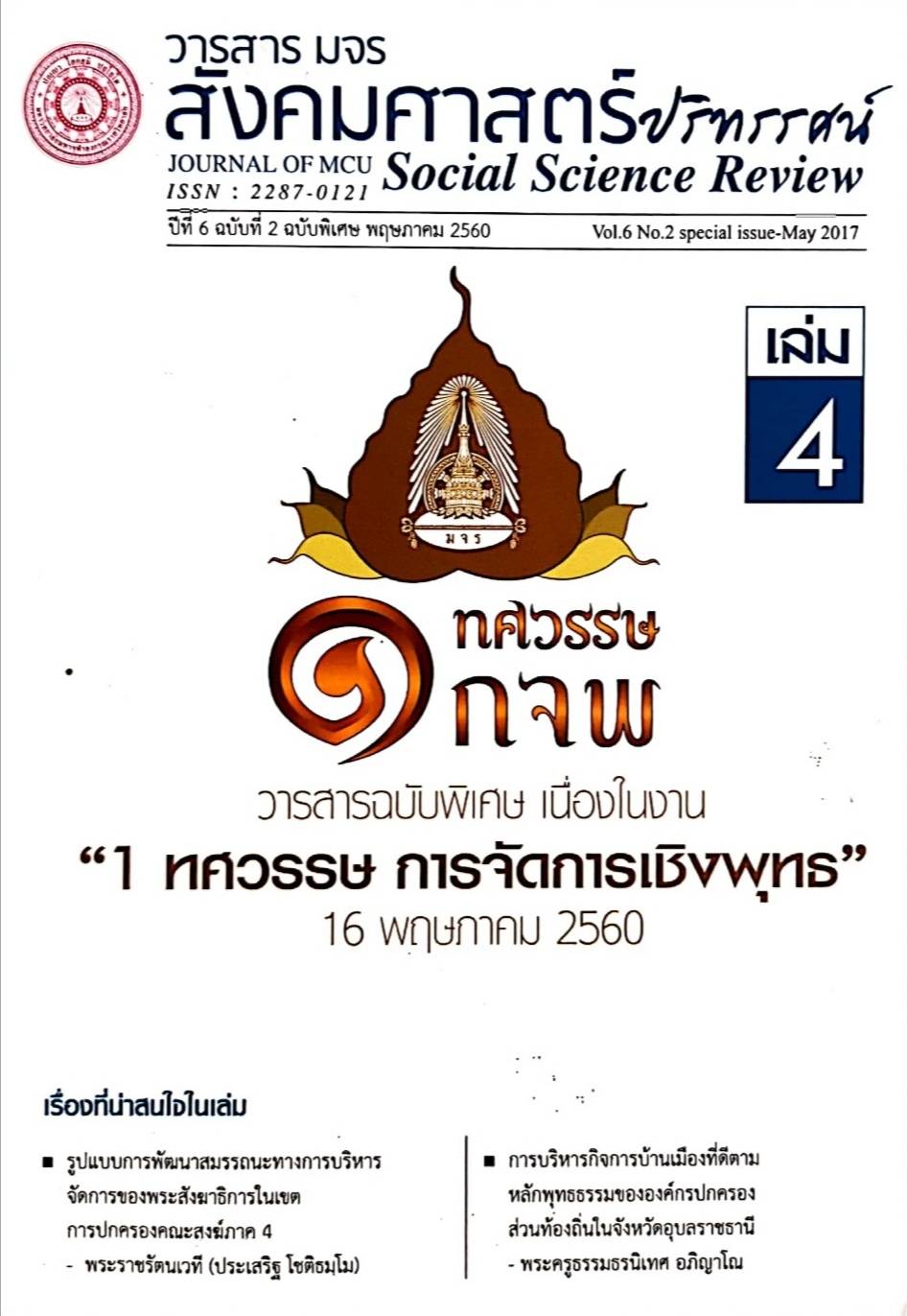กลยุทธ์การบริหารจัดการสำนักปฏิบัติธรรมในจังหวัดพระนครศรีอยุธยา
คำสำคัญ:
กลยุทธ์, สานักปฏิบัติธรรม, สัปปายะ, มหาสติปัฏฐาน 4, การบริหารจัดการบทคัดย่อ
บทความวิจัยครั้งนี้มีวัตถุประสงค์คือ 1. เพื่อศึกษาสภาพทั่วไปในการบริหารจัดการสานัก
ปฏิบัติธรรมในจังหวัดพระนครศรีอยุธยา 2. เพื่อศึกษาหลักพุทธธรรมและทฤษฎีเกี่ยวกับการบริหาร
จัดการสานักปฏิบัติธรรมในจังหวัดพระนครศรีอยุธยา 3. เพื่อนาเสนอกลยุทธ์การบริหารจัดการ
สานักปฏิบัติธรรมในจังหวัดพระนครศรีอยุธยา โดยเนนองคประกอบ 3 ดาน คือ ดานสถานที่ ดา
นบุคลากร และ ดานการบริหารจัดการ
ระเบียบวิธีวิจัยเปนการวิจัยแบบผสานวิธีระหวางการวิจัยเชิงปริมาณและการวิจัยเชิง
คุณภาพ การวิจัยเชิงปริมาณโดยใชแบบสอบถามกับ ผูเขาปฏิบัติธรรมในสานักปฏิบัติธรรมประจา
จังหวัดพระนครศรีอยุธยาจานวน 371 รูป/คน โดยใชวิธีการสุม ตัวอย่างแบบงายเครื่องมือเก็บ
ข้อมูลได้แก่แบบสอบถาม ซึ่งมีความเชื่อมั่นทั้งฉบับเท่ากับ 0.954 วิเคราะห์ข้อมูลด้วยสถิติ ได้แก่
ค่าความถี่ ค่าร้อยละ ค่าเฉลี่ยและค่าเบี่ยงเบนมาตรฐาน การวิจัยเชิงคุณภาพที่ดาเนินการวิเคราะห
ขอมูลจากเอกสาร ควบคูกับการสัมภาษณเชิงลึกจากผูใหขอมูลสาคัญ 35 รูป/คน เลือกแบบเจาะจง
จากผู้เชี่ยวชาญ เครื่องมือในการเก็บข้อมูลได้แก่ แบบสัมภาษณ์เชิงลึก (In-depth Interview) ที่มี
โครงสร้าง เก็บข้อมูลด้วยการสัมภาษณ์แบบเชิงลึก และเก็บข้อมูลจากผู้เชี่ยวชาญโดยทาการประชุม
สนทนากลุมเฉพาะ (Focus Group) 11 รูป/คน วิเคราะห์ข้อมูลจากทั้งสองขั้นตอนโดยการ
วิเคราะห์เนื้อหาเชิงพรรณาความ
ผลการวิจัย พบว่า
1. สภาพทั่วไปในการบริหารจัดการสานักปฏิบัติธรรมประจาจังหวัดพระนครศรีอยุธยา
ทั้ง 3 ด้าน คือ ด้านอาคารสถานที่ ด้านวิทยากร และด้านการบริหารจัดการพบว่า ในภาพรวมอยู่
ในระดับมาก เมื่อพิจารณาเป็นรายด้านพบว่า อยู่ในระดับมากทุกด้าน โดยภาพรวมด้าน
วิทยากรมีค่าเฉลี่ยในระดับมากที่สุด เมื่อพิจารณารายด้านพบว่า การเข้าใจหลักธรรมใน
พระพุทธศาสนาเป็นอย่างดี มีค่าเฉลี่ยในระดับมากที่สุด ด้านสถานที่ภาพรวมอยู่ในระดับ
มากเมื่อพิจารณารายด้านพบว่า มีการแบ่งแยกประเภทที่พักตามเพศของผู้ใช้ มีค่าเฉลี่ย
ในระดับมากที่สุด ด้านการบริหารจัดการภาพรวมอยู่ในระดับมาก เมื่อ
พิจารณารายด้านพบว่า เจ้าอาวาสหรือเจ้าสานักปฏิบัติธรรมมีความสนใจและเห็นความสาคัญของ
การศึกษา ปฏิบัติ และเผยแผ่พระพุทธศาสนาด้านวิปัสสนาธุระอย่างแท้จริง มีค่าเฉลี่ยในระดับมาก
ที่สุด
2. หลักพุทธธรรมและทฤษฎีในการบริหารจัดการสานักปฏิบัติธรรมควรใช้หลักพุทธธรรม
สัปปายะ7 ในการจัดการสถานที่ ได้แก่ 1) อาวาส (ที่อยู่ ) คือ เสนาสนะสัปปายะ 2) โคจรคาม 3)
ภัสสะ (การพูดคุย) คือ ธัมมัสสวนสัปปายะ 4) บุคคล คือ ปุคคลสัปปายะ 5) โภชนะ คือ
อาหารสัปปายะ 6) ฤดู คือ อุตุสัปปายะ 7) อิริยาบถ ด้านบุคคลใช้หลักพุทธธรรม มหาสติปัฏฐานสี่ได้แก่
1) กายานุปัสสนาสติปัฏฐาน 2) เวทนานุปัสสนาสติปัฏฐาน 3) จิตตานุปัสสนาสติปัฏฐาน 4)ธัมมานุปัสส
นาสติปัฏฐาน เป็นหลักในการอบรมเพื่อเพิ่มและพัฒนาครูสอนกรรมฐาน และใช้ทฤษฎีการบริหาร
POSDC ได้แก่ P. คือ Planning หมายถึง การวางแผน ผูบริหารที่ดีตองมีวิสัยทัศนเพื่อกำหนดทิศทาง
ขององคกร O. คือ Organizing หมายถึงการจัดองคกร สายบังคับบัญชาภายในองคกรมีการแบงงาน
กันทา S.คือ Staffing หมายถึงงานบุคลากร เปนการสรรหาบุคลากรใหมการพัฒนาบุคลากรและ
การใชคนใหเหมาะกับงาน D.คือ Directing หมายถึงการอานวยการเปนการสื่อสารเพื่อใหเกิดการ
ดาเนินการตามแผนผูบริหาร ตองมีมนุษยสัมพันธที่ดีและมีภาวะผูนาC.คือControlling หมายถึง
การกากับดูแลเปนการ ควบคุมคุณภาพของการปฏิบัติงานภายในองคกรรวมทั้งกระบวนการแกป
ญหาภายในองคกร มาประยุกต์ใช้ในการบริหารจัดการอย่างมีประสิทธิภาพเกิดประสิทธิผลสูงสุด
3. กลยุทธ์การบริหารจัดการสานักปฏิบัติธรรมประจาจังหวัดพระนครศรีอยุธยา ได้แก่ 1.
เสริมสร้างองค์ความรู้ด้านวิชากรรมฐาน โดยโครงการผลิตสื่อเพื่อช่วยสอนสาหรับพระวิปัสสนาจารย์
จัดทาสื่อธรรมะ เช่น หนังสือ ซีดี ธรรมะ ดีวีดี และสื่อต่างๆนาปฏิบัติกรรมฐาน และทาสื่อออนไลน์
ให้ผู้สนใจปฏิบัติสามารถเข้าถึงองค์ความรู้วิชากรรมฐานได้ง่ายขึ้น โครงการส่งเสริมการบรรยาย
ธรรมนาปฏิบัติ โครงการพัฒนาสื่อต่างประเทศ 2. ผลิตครูกรรมฐาน โดยโครงการฝึกอบรมพระ
วิปัสสนาจารย์ โครงการสร้างและพัฒนาบุคคลากรประจาสานักปฏิบัติธรรม โครงการส่งเสริม
ศักยภาพพระวิปัสสนาจารย์ประจาสานักปฏิบัติธรรม โครงการปฏิบัติธรรมตามรอยพระอริยสงฆ์
โครงการเชิดชูเกียรติบุคคล/องค์กร/สานักปฏิบัติธรรมต้นแบบ 3. พัฒนาสถานที่ใช้สอยให้คุ้มค่า
โดยโครงการพัฒนาสานักปฏิบัติธรรมให้เป็นศูนย์กลางชุมชน โครงการจัดตั้ง ส่งเสริมและพัฒนา
สานักปฏิบัติธรรม 4. ปรับภูมิทัศน์ให้เหมาะสม โดยโครงการปลูกต้นไม้เพื่อเป็นอุทยานในสานัก
ปฏิบัติธรรม โครงการปรับภูมิทัศน์สานักปฏิบัติธรรมเพื่อปฏิบัติศาสนกิจ โครงการพัฒนาลานธรรม
ลานจงกรม กุฏิกรรมฐานในสานักปฏิบัติธรรม โครงการสานักปฏิบัติธรรมต้นแบบ โครงการคัดเลือก
สานักปฏิบัติธรรมที่มีผลงานดีเด่น 5. พัฒนาฐานข้อมูลผู้รับบริการ โดยโครงการจัดเก็บข้อมูล สถิติ
การเข้าปฏิบัติของทุกสานักปฏิบัติธรรม โครงการพัฒนาระบบข้อมูลสารสนเทศ (MIS) ด้านการเข้า
รับอบรมการปฏิบัติธรรม 6. ใช้จ่ายงบประมาณอย่างโปร่งใส โดยโครงการส่งเสริมหลักธรรมาภิบาล
ในองค์กร ทาให้สามารถนากลยุทธ์ที่ได้ไปประยุกต์ใช้เพื่อพัฒนาปรับปรุงสานักปฏิบัติธรรมที่มีอยู่
ให้มีความเจริญก้าวหน้าเป็นสถานที่สัปปายะในการปฏิบัติธรรมเพื่อสามารถรองรับผู้ปฏิบัติธรรมได้
มากขึ้นอย่างเหมาะสมและใช้เป็นต้นแบบในการพัฒนาด้านต่างๆของสานักปฏิบัติธรรมที่ต้องการจะ
เป็นสานักปฏิบัติธรรมประจาจังหวัดดีเด่นต่อไป
เอกสารอ้างอิง
คณาจารย์ภาควิชาบริหารรัฐกิจ. (2549). สรุปเนื้อหาวิชาทฤษฎีองค์การ. กรุงเทพมหานคร :
สานักพิมพ์มหาวิทยาลัยรามคาแหง.
คณาจารย์มหาวิทยาลัยมหาจุฬาลงกรณราชวิทยาลัย. (2549). การปกครองคณะสงฆ์ไทย.
กรุงเทพมหานคร : โรงพิมพ์มหาจุฬาลงกรณราชราชวิทยาลัย.
คนึงนิตย์ และสุบรรณ จันทบุตร. (2545). ความสาเร็จในการปฏิบัติภารกิจของวัด : ศึกษาเฉพาะ
กรณีวัดหนองป่าพง จังหวัดอุบลราชธานี. กรุงเทพมหาคร : พริกหวานกราฟฟิค.
คูณ โทขันธ์ และเทพพร มังธานี. (2546). “รูปแบบการจัดการศึกษาและเผยแผ่ศาสนธรรมของ
วัดใน พระพุทธศาสนา : กรณีศึกษา วัดมหาพุทธาราม อาเภอเมือง จังหวัดศรีสะเกษ”.
รายงานการวิจัย. กรุงเทพมหานคร:สานักงานเลขาธิการการศึกษา. (อัดสาเนา).
พระธรรมโกศาจารย์ (ประยูร ธมฺมจิตฺโต). (2549). พุทธวิธีบริหาร. กรุงเทพมหานคร : โรงพิมพ์มหา
จุฬาลงกรณราชวิทยาลัย.
มหาจุฬาลงกรณราชวิทยาลัย. (2535). พระไตรปิฎกภาษาบาลี ฉบับมหาจุฬาเตปิฏก 2500.
กรุงเทพมหานคร : โรงพิมพ์มหาจุฬาลงกรณราชวิทยาลัย .
มาณพ พลไพรินทร์. (2541). คู่มือบริหารกิจการคณะสงฆ์. กรุงเทพมหานคร : กรมการศาสนา.
Campbell F Roald. (1997) Introduction to Educational Administration. Boston : Allyn
and Bacon.
Chapman.(1995) Supervisor Survival Kit. 2nded. California : Science Research
Associates lnc..
Cadge Wendy.(2002) Seeking the Heart : The First Generation Practices Theravada
Buddhism in America. Thesis Ph.D.. Otawa : The University of Chicago
Press.
Cronbach. Lee J. (1971) Essentials of psychological testing. 4th ed.. New York :
Harper & Row.
Don Hellriegel. (1982) Management. 3rd ed. Addison : Wesley Publishing Company.
lmc.. p.6.
Ernest Dale. (1973) Management : Theory and Practice. New York : McGraw-Hill. p.4.
Greenley. Gordone L. (1989) Strategic Management. London : Prentice-Hall.
Herbert A. Simon. (1947) Administrative Behavior. New york : Macmillian. p.3.
Hutchinson. Jonh G. (1967) Organization : Theory and Classical Concepts. New
York : McGraw-Hill.
Jauch. L & Glueck. W. (1988). Business Policy and Strategic Management. 5thed..
McGraw-Hill. New York.
Koontz. Harold &Cyril O’ Donnell. (1972) Principle of Management : An Analysis of
Managerial Functions. New York : McGraw-Hill. p. 43.
Porter. M. (1990) The Competetive Advantage of Nations. Havard Business Review.
March-April. PP.73-93.
Prof. Kenneth R. Andrews. L. (1971) The Concept of Corporate Strategy : R.D. Irvin.
Illinois.
ดาวน์โหลด
เผยแพร่แล้ว
รูปแบบการอ้างอิง
ฉบับ
ประเภทบทความ
สัญญาอนุญาต
ลิขสิทธิ์ (c) 2020 วารสาร มจร สังคมศาสตร์ปริทรรศน์

อนุญาตภายใต้เงื่อนไข Creative Commons Attribution-NonCommercial-NoDerivatives 4.0 International License.
เพื่อให้เป็นไปตามกฎหมายลิขสิทธิ์ ผู้นิพนธ์ทุกท่านต้องลงลายมือชื่อในแบบฟอร์มใบมอบลิขสิทธิ์บทความให้แก่วารสารฯ พร้อมกับบทความต้นฉบับที่ได้แก้ไขครั้งสุดท้าย นอกจากนี้ ผู้นิพนธ์ทุกท่านต้องยืนยันว่าบทความต้นฉบับที่ส่งมาตีพิมพ์นั้น ได้ส่งมาตีพิมพ์เฉพาะในวารสาร มจร สังคมศาสตร์ปริทรรศน์ เพียงแห่งเดียวเท่านั้น หากมีการใช้ภาพหรือตารางหรือเนื้อหาอื่นๆ ของผู้นิพนธ์อื่นที่ปรากฏในสิ่งตีพิมพ์อื่นมาแล้ว ผู้นิพนธ์ต้องขออนุญาตเจ้าของลิขสิทธิ์ก่อน พร้อมทั้งแสดงหนังสือที่ได้รับการยินยอมต่อบรรณาธิการ ก่อนที่บทความจะได้รับการตีพิมพ์ หากไม่เป็นไปตามข้อกำหนดเบื้องต้น ทางวารสารจะถอดบทความของท่านออกโดยไม่มีข้อยกเว้นใดๆ ทั้งสิ้น





